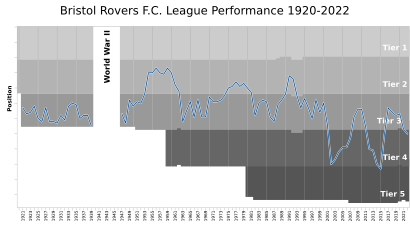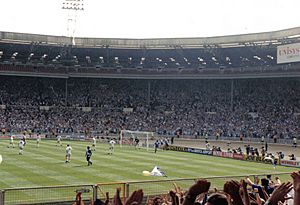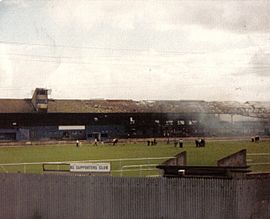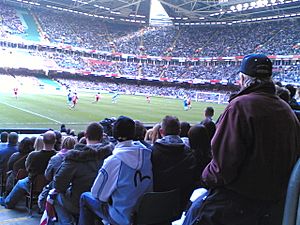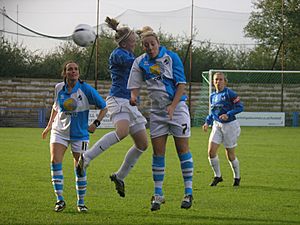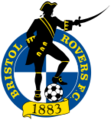Bristol Rovers F.C. facts for kids
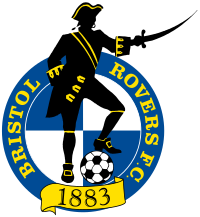 |
|||
| Full name | Bristol Rovers Football Club | ||
|---|---|---|---|
| Nickname(s) | The Pirates, The Gas | ||
| Founded | 1883 | ||
| Ground | Memorial Stadium | ||
| Capacity | 12,534 | ||
| Owner | Hussain AlSaeed | ||
| Head coach | Darrell Clarke | ||
| League | League One | ||
| 2018–19 | League One, 17th of 24 | ||
|
|
|||
Bristol Rovers Football Club is a professional football team for men based in Bristol, England. They are often called "The Pirates" because of Bristol's history as a port city. The team plays in League One, which is the fourth level of English football. They also have a women's team, Bristol Rovers W.F.C..
The club started in 1883 as Black Arabs F.C. and changed its name to Eastville Rovers in 1892. They moved to Eastville Stadium in 1897 and became Bristol Rovers two years later. In 1905, they won the Southern League and joined the Football League in 1920. They were promoted to the Second Division in 1953 and reached their highest league position, sixth place, twice in the 1950s.
Bristol Rovers has moved between different leagues over the years. They were relegated to the fourth tier in 2001. In 2007, they won a play-off final to get promoted. After dropping out of the Football League in 2014, they quickly returned in 2015 and then got promoted again in 2016. They were relegated from the third tier in 2021 but bounced back right away in 2022. In the 2024–25 season, they finished 22nd and will play in League Two again next season.
Locally, the team is also known as "The Gas." This nickname came from the gasworks that used to be next to their old Eastville Stadium. Fans of their rivals, Bristol City, first used it as a joke, but Bristol Rovers fans proudly adopted it. Games between these two Bristol teams are called the Bristol Derby. Bristol Rovers has won the Gloucestershire Cup 32 times and also won the Watney Cup in 1972.
Contents
History
Bristol Rovers has a long and interesting history, full of changes and important moments.
How it all started
The club began in September 1883 at the Eastville Restaurant in Bristol. It was first named Black Arabs F.C. because of the rugby team called "Arabs" and the black kits they wore. This name only lasted for one season. In 1884, to attract more local fans, the club was renamed Eastville Rovers.
For a few years, the club only played friendly matches. In 1892, they helped start the Bristol and District League, which later became the Western League. In 1897, Eastville Rovers became a professional team and changed its name to Bristol Eastville Rovers. On February 17, 1899, the name officially became Bristol Rovers. They joined the Southern League in 1899 and won the league title in 1905.
Joining the Football League
In the 1920–21 season, Bristol Rovers joined the new Division Three of the Football League. They stayed in this division for over 30 years. In the 1952–53 season, they won the league and were promoted.
The team has been promoted seven other times. They moved up to the Second Division in 1974 and again in 1990. They also earned promotions in 2007, 2015, 2016, and 2022. The club has been relegated eight times, most recently at the end of the 2024–25 season.
Bristol Rovers' highest league position was sixth place in the Second Division, which they achieved twice (in 1956 and 1959). They were very close to reaching the top league in 1956, missing out by just four points. In 2014, Rovers were relegated to the Conference for the first time. However, they quickly returned to the Football League in 2015 by winning a play-off final against Grimsby Town.
In 2016, the al-Qadi family from Jordan bought most of the club. Wael al-Qadi became the president. In 2023, Kuwaiti businessman Hussain AlSaeed bought a controlling share of the club and became chairman.
Cup competitions
Bristol Rovers has won a few important cup competitions. Their biggest cup win was the 1972 Watney Cup, where they beat Sheffield United in the final. They also won the Division Three (South) Cup in 1935 and the Gloucestershire Cup 32 times.
In the FA Cup, Rovers have reached the quarter-finals three times. The first time was in 1951, when they played Newcastle United in front of a record crowd of 62,787 fans. They reached the quarter-finals again in 1958 and most recently in 2008. In 2002, they became the first third-division team to beat a Premier League side away from home in the FA Cup, winning 3–1 against Derby County.
They have also reached the final of the Football League Trophy twice, in 1990 and 2007, but finished as runners-up both times.
Rivalries

Bristol Rovers' biggest rivals are their city neighbours, Bristol City. Matches between them are known as the Bristol derby. This rivalry is considered one of the fiercest in English football. The last time they played was on September 4, 2013, when City won 2–1.
Rovers also have rivalries with other teams from the West Country region. These include Newport County, Swindon Town, Cheltenham Town, Yeovil Town, and Forest Green Rovers.
Colours and badge
|
|
| Team colours from 1883 to 1885 |
Bristol Rovers is famous for its blue and white quartered shirts, which they have worn for most of their history. The current home kit features these blue and white quarters with white shorts.
When the club started as Black Arabs F.C. in 1883, they wore black shirts with a yellow sash. From 1885 to 1899, they wore blue and white hooped shirts. Then, until 1919, they wore black and white striped shirts.
When Rovers joined the Football League in 1920, they wore white shirts with blue shorts. In 1931, the blue and white quarters were first introduced. This design was meant to make the players look bigger and more intimidating. They wore the quarters for 31 years before changing to blue pinstripes on a white background.
|
|
| Team colours on winning the Southern League in 1905 |
After trying different designs, including blue and white stripes and all-blue kits, Rovers returned to the blue and white quarters in 1973. They have kept this design ever since. In the 1996–97 season, they wore a striped quartered design that fans jokingly called the "Tesco bag shirts" because they looked like the company's carrier bags.
The club badge features a pirate, which matches their nickname, "The Pirates." Earlier badges also showed a blue and white quartered design, inspired by the team's shirts.
Kit suppliers and sponsors
Bristol Rovers first had an official kit supplier, Bukta, in 1977. Their first kit sponsor was Great Mills in 1981. Errea was their longest-running kit supplier, providing kits for eleven years (2005–2016). Cowlin Construction was the club's longest-running shirt sponsor, lasting 11 years until 2009. Since 2019, Utilita Energy has been the main shirt sponsor.
Stadium
Bristol Rovers plays its home games at the Memorial Stadium in Horfield. They moved there in 1996 and bought the stadium two years later.
Stadium history
When Bristol Rovers started as Black Arabs F.C. in 1883, they played at Purdown. They then moved to Three Acres for seven years. After that, they had short stays at other grounds like Schoolmasters Cricket Ground, Durdham Down, and Ridgeway.
For most of their history, Bristol Rovers played at Eastville Stadium for 89 years, from 1897 to 1986. Due to money problems, the team had to leave Eastville, which is now an IKEA store. Bristol Rovers then played at Twerton Park in Bath, the home of Bath City, for 10 years before returning to Bristol in 1996.
Rovers also played five home games at Ashton Gate Stadium, the home of their rivals Bristol City, after a fire destroyed part of Eastville Stadium in August 1980. They returned to Eastville in October 1980.
Over the years, there have been plans to build a new stadium or redevelop the Memorial Stadium. In 2011, the club planned a new stadium at the University of the West of England's Frenchay campus, but these plans were stopped in 2017. The club then focused on improving the Memorial Stadium. In 2020, the club started building a new training facility in Almondsbury, which includes pitches, a gym, and a clubhouse. In October 2023, the new owner confirmed that the club would redevelop the Memorial Stadium instead of moving to a new site.
Supporter culture
Most Bristol Rovers fans come from north and east Bristol and South Gloucestershire. Many towns and villages nearby also have a lot of Rovers supporters.
Bristol Rovers supporters are known as "Gasheads." This name originally came from fans of rival team Bristol City, who used it to refer to the large gas works near Rovers' old Eastville Stadium. The smell from the gas works sometimes drifted over the crowd. However, Rovers fans proudly adopted "Gasheads" as their own nickname. The chant "Proud to be a Gashead" became popular, and there was even a fan magazine called The Gashead.
The term "Gasheads" is now widely accepted as referring to Bristol Rovers supporters. In 2001, the club even dedicated the squad number 12 to the Gasheads, calling them the club's "12th Man" to show appreciation for their loyal support.
One active fan magazine is called Last Saturday Night. There is also a fan-run podcast and blog called GasCast.
Club song
The song most connected with Bristol Rovers is "Goodnight, Irene", written by Lead Belly. People have different ideas about how it became the club song. One theory is that it became popular in the 1950s when a version of the song was in the British music charts. The line "sometimes I have a great notion to jump in the river and drown" seemed fitting when Rovers lost, as the Bristol Frome flows near the old Eastville ground.
Another popular Bristol Rovers song is "Tote End Boys," written by Ben Gunstone. The name comes from the "Tote End" terrace at Eastville Stadium, where many Gasheads used to stand.
Players
Bristol Rovers has a team of professional players who compete in their league. The club also has a development squad and Under-18s team, helping younger players grow their skills.
Notable former players
The club has a Hall of Fame to honor players and managers who have made a big impact. The first person inducted was Geoff Bradford, who scored the most goals for the club. Other famous players include Stuart Taylor, who played the most games, and Alfie Biggs, the second-highest goal scorer.
Some other notable former players include:
- Ronnie Dix: The club's youngest ever player and the Football League's youngest ever goalscorer.
- Ian Holloway: A former player and manager who is still a big fan of the club.
- Nigel Martyn: Became the first goalkeeper to be sold for a million pounds when he moved to Crystal Palace.
- Barry Hayles: Was sold to Fulham for a club record fee of £2,600,000.
- Vitālijs Astafjevs: The most internationally capped Bristol Rovers player, playing 31 times for Latvia while at the club.
Club staff
Bristol Rovers has a team of staff who help run the club, including the head coach, assistant coaches, medical staff, and recruitment team. The club is currently managed by Darrell Clarke.
Youth Academy
The Bristol Rovers Academy helps young players develop their football skills. Some players who have come through the Academy and gone on to play for the first team include Alfie Kilgour, Kofi Shaw, and Jed Ward. The Academy has also produced players who have gone on to play for bigger clubs, like Scott Sinclair, who signed for Chelsea in 2005.
Women's team
Bristol Rovers used to have a women's team, Bristol Rovers W.F.C., which started in 1998. This team later changed its name to Bristol Academy W.F.C. in 2005. In 2016, Bristol Academy was rebranded as Bristol City due to a sponsorship.
In 2019, Bristol Rovers announced they would restart their women's team. They now have two teams playing in the Gloucestershire County Women's Football League.
Records
Bristol Rovers holds several club records:
Scorelines
- Biggest League Win:
- 7–0 (against Brighton & Hove Albion, 1952)
- 7–0 (against Swansea City, 1954)
- 7–0 (against Shrewsbury Town, 1964)
- 7–0 (against Alfreton Town, 2015)
- 7–0 (against Scunthorpe United, 2022)
- Biggest Cup Win:
- 6–0 (against Merthyr Tydfil, FA Cup, 1987)
- 6–0 (against Darlington, FA Cup, 2020)
- Biggest League Defeat: 0–12 (against Luton Town, 1936)
Players
- Most League Appearances: 546 – Stuart Taylor (1966–1980)
- Most Goals for Club: 242 – Geoff Bradford (1949–1964)
- Most Goals in a Season: 33 – Geoff Bradford (1952–53)
- Highest Transfer Fee Paid: £375,000 – Andy Tillson (from Queens Park Rangers, 1992)
- Highest Transfer Fee Received: £2,600,000 – Barry Hayles (to Fulham, 1998)
Other records
- Record Home Attendance: 38,472 (against Preston North End, FA Cup, 1960)
- Best FA Cup Performance: Quarter-finals (1951, 1958, 2008)
- Best League Cup Performance: Quarter-finals (1971, 1972)
- Best Football League Trophy Performance: Runners-up (1990, 2007)
Honours
Bristol Rovers has won several titles and promotions throughout its history:
League
- Third Division South / Third Division (level 3)
- Champions: 1952–53, 1989–90
- Runners-up: 1973–74
- Fourth Division / League Two (level 4)
- Promoted: 2015–16, 2021–22
- Play-off winners: 2007
- Conference Premier (level 5)
- Play-off winners: 2015
- Southern League
- Champions: 1904–05
- Western League
- Champions: 1899–1900
Cup
- Associate Members' Cup / Football League Trophy
- Runners-up: 1989–90, 2006–07
- Third Division South Cup
- Winners: 1934–35
- Watney Cup
- Winners: 1972
- Gloucestershire Cup
- Winners (32 times): 1888–89, 1902–03, 1904–05, 1913–14, 1924–25, 1927–28, 1934–35, 1935–36, 1937–38, 1947–48, 1948–49, 1950–51, 1953–54, 1954–55, 1955–56, 1958–59, 1962–63, 1963–64, 1964–65, 1965–66, 1967–68, 1973–74, 1974–75, 1981–82, 1982–83, 1983–84, 1984–85, 1988–89, 1989–90, 1992–93, 1993–94, 1994–95
Images for kids
See also
 In Spanish: Bristol Rovers Football Club para niños
In Spanish: Bristol Rovers Football Club para niños



